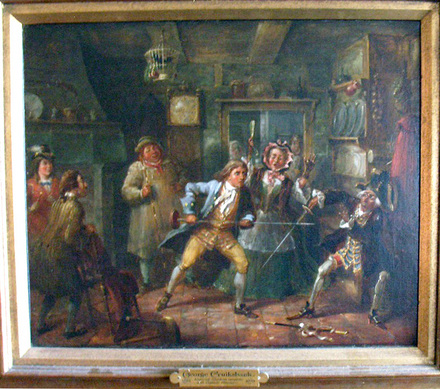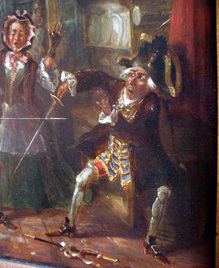Finished in 1859, Cruikshank submitted the painting to the annual member’s show at the British Institution. All of the nearly 600 works in the exhibit were listed in The Art Journal London (v. 5) along with brief, unflattering remarks.
The review begins, “Again the Art-season commences: the British Institution is open, its walls are covered with pictures on every available space where they can be seen, and even where they cannot be seen… . The exhibited works amount to five hundred and ninety-two, among which are amply represented every department of Art except one, and that one is (the old story) what is called history. That which we know as “high Art” is denounced as ungrateful to the painter; but it is not that “high Art” is ungrateful, but that it demands for its themes the rarest gifts of the painter and the poet.
Mediocrity in the highest walk of painting is intolerable; but mediocrity in low Art sells readily. On looking round on these walls, the eye is met by declarations of the most fearful depravity of taste in the choice of subject; and right earnestly do the painters devote themselves to the consecration of their unworthy themes.”
No. 435 was Cruikshank’s Roderick Random’s Encounter with Captain Weasel, about which the reviewer adds only, “This is not so eccentric as some of the recent works of the artist, inasmuch as it would be difficult to exceed the extravagance of the text.”
In The Literary Gazette, a second reviewer commented: “George Cruikshank has a picture that of course has fun in it … but it proves that a design which would be irresistible in a wood-cut two-inches square, may prove a very vapid affair when magnified into an oil painting of as many feet.”
Tobias Smollett (1721-1771), The Adventures of Roderick Random (London: James Cochrane and Co.; J. Andrews, 1831). Graphic Arts Cruik 1831.

